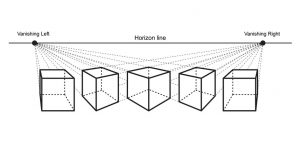For any type of artwork, the horizon line is an essential part of making your art more realistic. It helps you to scale the subjects in your drawing or painting properly, and it provides a sense of three-dimensionality to a strictly two-dimensional surface. As such, understanding what the horizon line is and how it works is one of the first steps you need to take in improving your artwork.
What is the horizon line?
In a drawing or painting, the horizon line is the point where the earth meets the sky. It is always at eye-level—no more and no less. While not all works of art depict the horizon (after all, plenty of paintings and drawings feature interior settings rather than exteriors), artists will create an eye-level line to ensure that the subjects are in the proper perspective.
Why do we need to use it?
Simply put, a horizon line helps us to create perspective. Linear perspective is an artistic technique that makes a 2D surface appear three-dimensional by creating an illusion of depth. Think about it. Objects that are farther away from us appear small, while objects that are closer to us appear big. Thus, to make a painting or drawing realistic, we have to replicate this by making subjects that are further away smaller, and items that are closer to us bigger. We can do this by creating a horizon line with a vanishing point as a point of reference.
Horizon lines and linear perspective are crucial techniques for beginner artists to learn. At Creative Ventures Gallery, our beginner drawing classes can teach you the basics of horizon lines, linear perspective, and more so that you can reach new creative heights. Give us a call today at 603-672-2500 to learn more.

